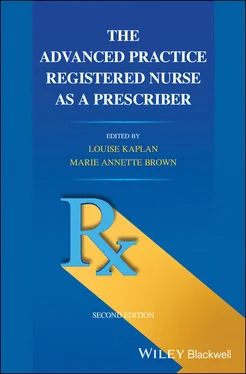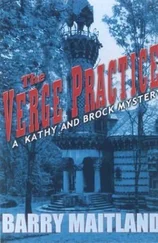Chapter 2guides the reader through an analysis of the role and responsibilities of the APRN as a prescriber. The ability to independently prescribe medications symbolizes the legitimacy of APRNs. The public often perceives the prescribing role as what defines the legitimacy of APRNs. This chapter includes an overview of the development of the APRN role and prescriptive authority, the essential nature of autonomy, and the process of transition to the prescribing role. The chapter emphasizes the shift from prescribing medication based on professional preference and tradition to rational prescribing and evidence‐based practice as strategies to achieve quality patient‐centered care.
Given the multiple factors that influence the transition of the APRN to the prescriber role, there is an understandable degree of uncertainty and concern about prescribing. Challenges about the transition from a role that requires administration of medications and prescribed treatments as a registered nurse to the role of manager of care and prescriber as an APRN are delineated in Chapter 2. Change can be a professionally invigorating challenge rather than a distressing situation. It is understandable, however, that many role transitions are characterized by uncertainty and even fear along with the excitement and promise of change.
Chapter 3highlights the multitude of challenges and opportunities that APRNs confront when prescribing medication. Laws, regulations, and policies, as well as the attitudes of other health professionals often limit prescribing. These are external barriers to an APRN’s adoption of the prescribing role. Internal barriers also can diminish an APRN’s interest in fully autonomous practice and can be overlooked in an analysis of barriers to APRN prescribing. Internal barriers to “stepping up” are invisible or unacknowledged factors within the individual APRN, and include personal characteristics such as conflict avoidance or the “need to be liked.” Strategies to overcome internal and external prescribing barriers are offered as a way to generate enthusiasm among APRNs for facilitating change as well as to deepen their courage to take the inherent risks in full practice authority.
Chapter 4details the laws, regulations, and professional issues that affect prescribing. These include state laws, Board of Nursing rules, and interprofessional constraints. Fully autonomous prescribing is contrasted with examples of restricted prescribing authority. Restrictions include the requirement for physician supervision, the need to use formularies, and the lack of authority to prescribe controlled substances.
The Consensus Model for APRN Regulation, Licensure, Accreditation, Certification and Education was a landmark agreement developed over several years of dialogue and negotiation by representatives of education, state Boards of Nursing, and professional practice organizations. Discussion of the Consensus Model highlights the need for standardized regulation that achieves fully autonomous practice with full prescriptive authority and universal adoption of the term APRN. This chapter can assist APRNs across the nation to visualize and positively anticipate their future practice and prescribing.
Chapter 5provides an overview of APRN and registered nurse (RN) prescribing globally. Overall, more countries have adopted RN prescribing than APRN prescribing. The nurse practitioner (NP) role is the most widespread of the four APRN roles, particularly because midwifery is not always a nursing role worldwide. The chapter discusses different approaches to RN and NP prescribing such as through task sharing, formularies, and independent authority.
Chapter 6coaches APRNs to deal with difficult and often complex clinical situations that are inherent in human relationships and professional interactions, even among experienced and dedicated APRNs. These situations often create anxiety and may even generate anger when the APRN feels ill‐prepared to deal with them. The basic tenet is that these are not problem patients but situations for which the APRN needs more knowledge, skill, and insight from self‐reflection. Examples of these situations include dealing with patients who are or appear to be seeking controlled substances, are angry, request inappropriate care such as antibiotics for a viral infection, and who violate boundaries. One goal of the discussion is to enhance understanding of why these difficult situations develop and how they can impact patient‐centered care. Specific strategies to identify difficult situations, respond to them appropriately, and build competence as a supportive and courageous APRN prescriber are discussed.
Chapter 7discusses the characteristic clinical challenges inherent in prescribing controlled substances and the strategies to address them. This information is particularly relevant in the midst of an opioid epidemic in the United States. Accurate definitions of terms related to drug use or misuse and their application provide a rationale to create more skillful communication with patients around complex and sensitive issues. The use of deliberate, concrete approaches to prescribing controlled substances such as an opioid use agreement with a patient are key strategies to build prescribing expertise. A wide range of topics is discussed and include: “universal precautions” for use with the prescription of controlled substances; the assessment, management, and monitoring of patients with chronic non‐cancer pain; clinical guidelines; the use of prescription drug monitoring programs; providing medication therapy for people with substance use disorder; and standards for the identification of a patient who misuses substances.
Chapter 8helps APRNs become savvy prescribers and avoid missteps during their career. A series of case exemplars highlight common mistakes that resulted in legal action. Prescriptive authority for APRNs is based on federal laws about controlled substances, state laws, and the standard of care necessary across various classes of drugs. These exemplars highlight the role of Boards of Nursing, malpractice attorneys when a lawsuit is filed, the Drug Enforcement Administration, and government auditors who monitor nursing facilities. An overview of malpractice insurance and risk mitigation provides the APRN with strategies to protect one’s practice and prescribe safely.
Chapter 9introduces the rapidly evolving landscape of medical marijuana which is now legal in several countries worldwide. Although illegal at the federal level in the United States, over three‐dozen states and jurisdictions have legal medical, and in some instances recreational, marijuana. While APRNs do not “prescribe” medical marijuana, in some of the states one or more of the APRN roles may provide patients with “authorizations” to use medical marijuana. This chapter includes a brief overview of marijuana as a drug, federal and state law, the typical process to provide an authorization, standards of care, and the evidence‐base for medical marijuana. While no APRN is required to provide an authorization in states where it is permitted, all APRNs will want to know the law in their state of practice and be prepared to answer questions and use an evidence‐based approach to assist patients in their decision making.
Ultimately, this book is more than a guide and reference for building and enhancing prescribing expertise. It honors the work of APRNs who use prescriptive authority to provide comprehensive quality care. The book is a tribute to the countless number of APRNs who have worked tirelessly for full practice and prescriptive authority and those who have invested decades of their careers to become expert prescribers. Toward that end, we hope the book is an inspiration to students. You are the next generation of APRNs who are urgently needed to join current advocates in the efforts to obtain full prescriptive authority nationwide. We look forward to the day this is achieved.
Читать дальше












